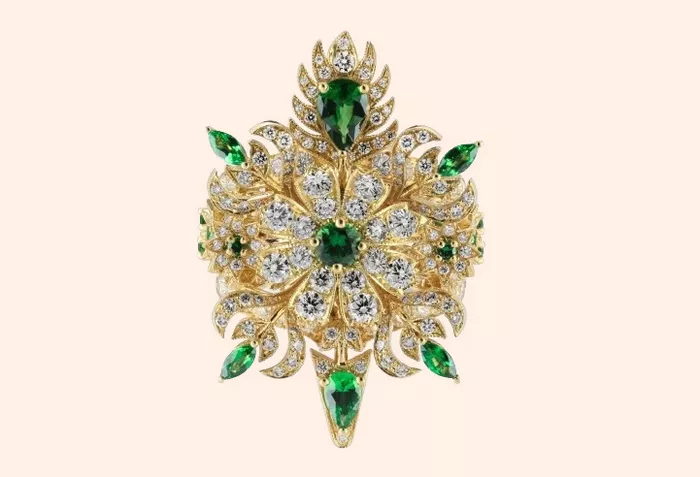The Roman god Janus, symbolizing duality with his two faces looking in opposite directions, aptly represents the jewelry market’s split: ultra-expensive, unique fine jewelry pieces (typically above £80,000) for the wealthy, and affordable items often under £1,000 for aspirational buyers. Now, however, a new focus is emerging in the middle: mid-priced jewelry ranging from £10,000 to £100,000.
In April of last year, Cartier introduced its Tressage collection during Milan Design Week, starting at £11,400 for a ring adorned with golden beads. Later in the year, Gucci showcased its Flora range at London’s Savoy Hotel, featuring mid-priced jewelry with pavé diamonds and colored gemstones in botanical motifs inspired by the brand’s archives. Louis Vuitton also entered this space with its LV Diamonds collection, highlighting a custom-cut diamond echoing the house’s logo, priced into the five digits.
Brands are expanding their mid-range offerings by enhancing entry-price designs or adapting high jewelry pieces at more accessible price points. For instance, Bulgari continually unveils new, more abstract, and less expensive versions of its iconic Serpenti designs. Similarly, Chaumet reinterprets its core collections—Joséphine, Bee My Love, and Liens—to attract clients across various price points, from entry-level to mid-range.
Mid-priced jewelry accounts for about a fifth of Chaumet’s offerings. According to Claudia D’Arpizio, global head of fashion and luxury at Bain & Co, this segment can represent 30-70% of a brand’s turnover. She attributes its expansion to the overall growth in the jewelry sector. “Over the past five to 10 years, growth has been spread across all segments,” D’Arpizio says. “Post-Covid, high jewelry has generally outperformed, while growth in other segments has been driven by brands’ ability to play across all price points.”
Cynthia Tabet, global product marketing director at Piaget, emphasizes the importance of mid-priced jewelry in attracting new clients and showcasing a brand’s design language and craftsmanship. To celebrate its 150th anniversary, Piaget launched a new capsule collection of its Possession range, elevating the design with gold-engraving techniques and chain motifs typical of its high-end pieces.
Mauro di Roberto, Bulgari’s jewelry managing director, underscores the strategic value of mid-priced jewelry. “The medium-priced jewelry segment is crucial for luxury brands,” he says. “It helps maintain image while expanding client base and market reach. It can attract a wider audience, introduce new customers to the maison’s aesthetic and values, and foster brand loyalty that could lead to future high-end sales.”
As established houses enrich their offerings and new players enter the market, mid-priced jewelry is becoming the entry point for high jewelry clients. “Purchasing medium-priced jewelry allows clients to become acquainted with the maison and its offerings, building trust in the quality and service without making a significant financial commitment,” says Di Roberto.
For Gucci, mid-priced jewelry serves as an ambassador category, attracting new customers, especially in regions where the brand lacks a fashion retail presence. Financially, mid-priced pieces provide solid returns because their prices are typically non-negotiable, unlike high jewelry. “The situation for medium-priced jewelry is closer to that of entry prices, with list prices that are ‘not negotiable’ and pricing structures set to preserve target margins,” says D’Arpizio.
Despite the opportunities, large houses face competition from independent jewelry artists like Fabio Salini, Otto Jakob, and Lily Gabriella, who cater to clients seeking bespoke creations. Designing successful mid-priced pieces presents challenges, balancing quality, aesthetics, and cost-efficiency. “The goal is to create jewelry that represents the DNA, unique design, high craftsmanship standards, and high-quality performance at the right price,” says Di Roberto.
Cynthia Tabet at Piaget agrees, noting that mid-priced jewelry must meet the high standards of high jewelry while adhering to marketing and pricing constraints of fine jewelry. Despite the challenges, the rewards seem worth the effort, reflecting the Roman saying: “in medio stat virtus” (virtue lies between extremes).

